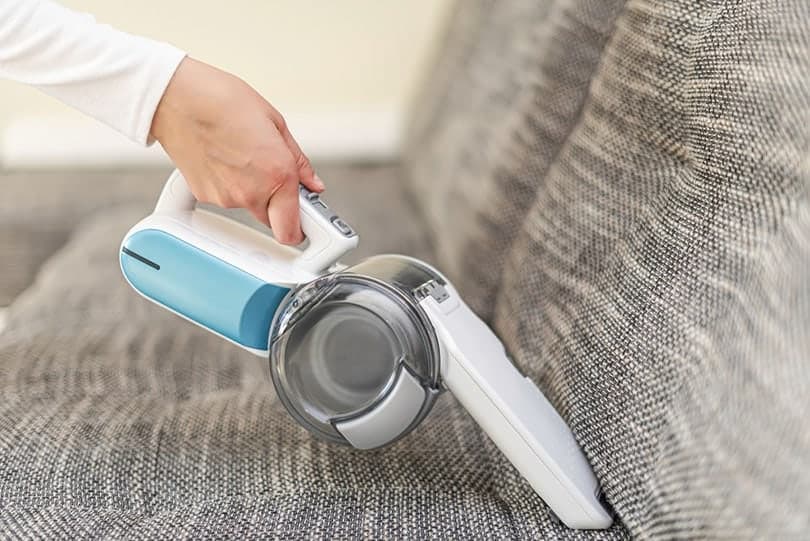Labrador Retrievers are one of the most charming dogs on the planet. These gentle giants are loyal, loving, and always ready to fetch a ball or cuddle up on the couch. They’re also great with kids and make wonderful family pets.
Unfortunately, Labradors are not hypoallergenic. These goofy furballs shed. A lot. Labradors have a thick, double coat that helps protect them from the elements. But that same coat also means that they’re constantly shedding throughout the year. It’s worse during the shedding season (spring and fall) when they shed their coat and lose even more fur.
All that fur means they’re scattering dander all over the place, which is one of the most common triggers of pet allergies. Still, don’t give up on having a dog just yet. If you’re allergic to dogs but still want to bring a pup home, there are a few things you should know.
How Dog Allergies Work
Contrary to popular belief, dog fur by itself does not trigger allergies. It’s actually the proteins found in a dog’s skin, saliva, and urine that can trigger allergic reactions in sensitive people. Often, pet allergies are caused by exposure to the dead flakes of skin or dander that a pet sheds.
Labradors and other dogs with double coats are especially problematic for allergy sufferers. That’s because the outer layer of their fur (the guard hair) repels dirt, water, and other allergens. But as that top layer rubs against the undercoat, it loosens the dead skin cells and dander trapped in the fur.
Those allergens then become airborne and can cause sneezing, watery eyes, and other allergy symptoms in sensitive people.
Not sure if you’re allergic to dogs? The best way to find out is to spend time with a friend or family member’s dog. If you have any allergy symptoms (sneezing, coughing, watery eyes, etc.) within 30 minutes of being around the dog, you’re probably allergic.

There’s No Such Thing as a Hypoallergenic Dog
If someone tries to sell you a “hypoallergenic” dog, they’re probably not being truthful. The reason? All dog breeds shed, which means they can all trigger allergies in one way or another.
The more accurate term would be “low shedding” because the less a dog sheds, the less dander and allergens they’ll likely produce.
Some of the lowest-shedding, and therefore “hypoallergenic,” dog breeds include:
- Bichon Frise
- Maltese
- Poodle
- Shih Tzu
- Yorkshire Terrier
While these dogs may trigger fewer allergies, there’s still no guarantee that they won’t trigger symptoms. The only way to know for sure is to spend time with the dog and see if you have a negative reaction.
How to Reduce Pet Allergies
We won’t stop you from getting a Labrador if you’re set on it. Those charmers are impossible to resist! If you’re allergic to dogs, regardless of the breed, here are some tips on managing your allergies:
1. Keep Your Dog Out of the Bedroom
This is probably the most important thing you can do to reduce your allergy symptoms. By keeping your dog out of your bedroom, you’re creating an allergen-free space where you can go to escape the sneezing and watery eyes.
2. Vacuum Regularly With a HEPA Filter
Regular vacuuming is important for all homes, but it’s especially important for homes with pets. A vacuum with a HEPA filter will help trap allergens and keep them from recirculating through the air.

3. Groom Your Dog Often
Brushing your dog’s fur helps remove dead skin cells, dander, and other allergens that can trigger an allergic reaction. It also helps reduce shedding, which means there will be fewer allergens floating around your home.
Use a deshedding shampoo and comb to help remove loose fur and dander. And be sure to brush your dog outdoors to avoid making a mess inside.
4. Talk to Your Doctor About Allergy Medication
If you’re struggling to manage your allergies, talk to your doctor about allergy medication. There are a variety of over-the-counter and prescription options available that can help reduce your symptoms.
5. Consider a Home Makeover
The fewer surfaces there are for allergens to collect, the better. That means replacing carpet with hardwood floors, using blinds instead of curtains, and switching out your couch with a leather loveseat.
You might also want to consider an air purifier for your home. Air purifiers help remove allergens, dust, and other particles from the air, making it easier to breathe.
Final Thoughts
If you’re allergic to dogs, a Labrador Retriever is probably not the best breed for you. Don’t be fooled by the hypoallergenic label, either. But if you’re set on getting a Lab–or any dog breed–take precautions and manage your symptoms so you can enjoy life with your new best friend.
Featured Image Credit: Tina Rencelj, Shutterstock
















